Galleries have been offering works to buyers digitally since at least the early days of smartphones. But back then, emailed JPGs and PDF checklists were usually used to whet clients’ appetites for works they would still need to see in person before acquiring.
Even when many, if not most, premier galleries caught e-commerce fever, hardware and software drawbacks potholed the road to progress. The VIP Art Fair, the industry’s first trade show to take place entirely online, made the wrong kind of history thanks to debilitating glitches in its 2011 debut and another bout of lackluster sales the following year. David Zwirner even called the 2012 fair “a waste of time.”
Six years later, however, the game has changed in a big way—offline as much as on. Somewhat ironically, considering his displeasure with VIP, David Zwirner estimated in a Wall Street Journal profile this January that 30 percent of his clients now buy work “solely on the basis of emailed images.”
Yet it’s still up for debate whether the rise in remote participation qualifies as a net positive or negative for the industry. As our phones increasingly mediate our relationship to culture, and as art fairs supply an ever-growing chunk of many dealers’ annual sales, galleries around the world have begun lamenting a foot-traffic recession at their permanent spaces. This development has pushed even premier sellers to reconsider their digital strategies, from websites to social media and beyond.
Although a select group of galleries made overtures toward direct-to-consumer online sales years ago, it is only recently that two of the heaviest hitters have truly leaned in—a sensible outcome, given that top-selling galleries have both the most resources to experiment with and the least to lose if the test tubes explode.
So now Zwirner and Gagosian are taking big swings at reshaping the narrative of digitally enabled sales with their own self-described online viewing rooms. And their respective approaches to e-commerce today highlight important characteristics of a changing industry—as well as offer some surprising clues about where it might be headed.
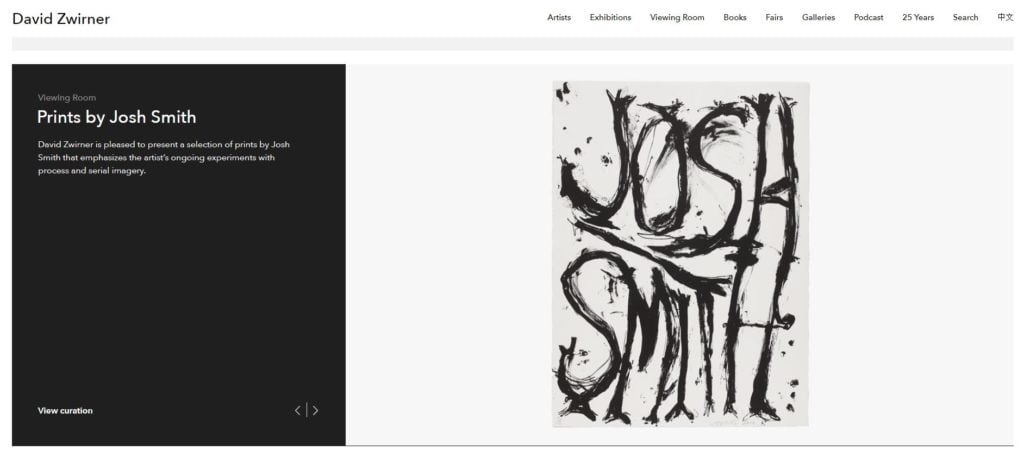
Screenshot of David Zwirner’s online Viewing Room. Courtesy of David Zwirner, New York/London, Hong Kong.
Zwirner’s First Mover Advantage
Zwirner launched its inaugural online viewing room in January 2017. The format’s mandate is to “curate small exhibitions to tempt the audience that is extremely comfortable interacting with us online,” David Zwirner told artnet News. In the 18 months since the feature’s debut, the gallery has continuously cycled new presentations through the “room,” just as it does with its physical exhibition spaces. Access is available to anyone on Zwirner’s website at any time, in exchange for their name and email address.
The online viewing room’s design is simple, direct, and should be familiar to anyone who has ever shopped for anything online. A few paragraphs of text introduce the works, which are presented via thumbnails, along with price and availability status. However, collectors cannot complete an acquisition online. They can only click an “inquire” button, after which they will be contacted by a gallery representative.
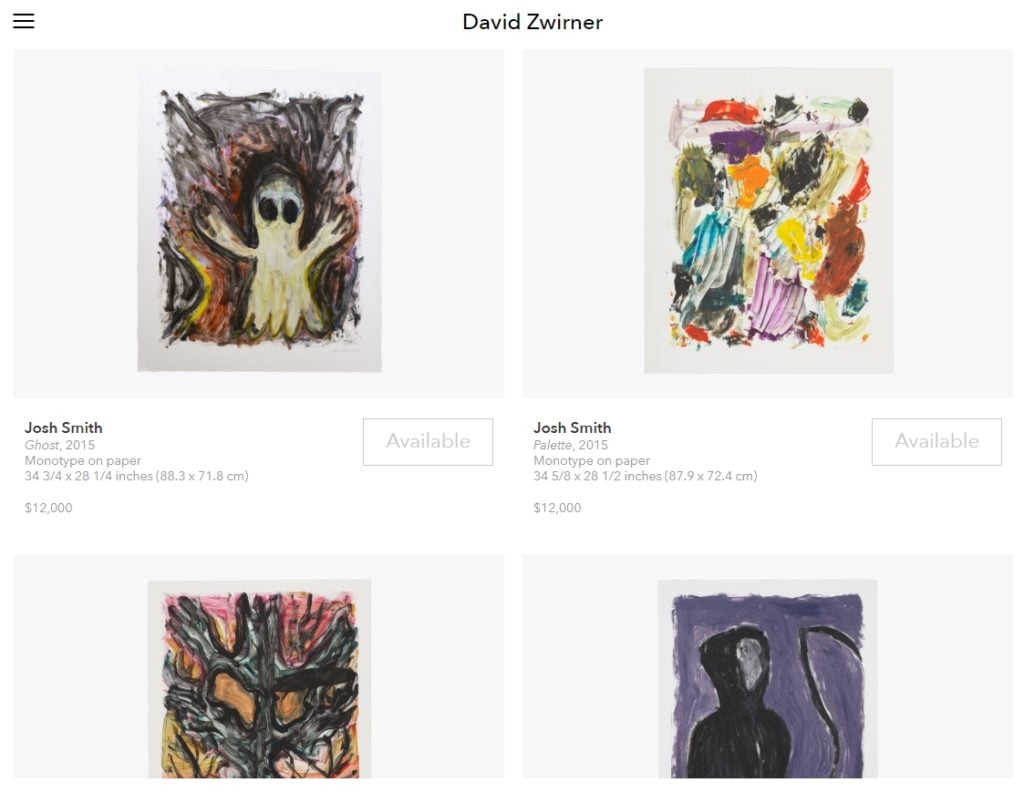
Screenshot of David Zwirner’s online Viewing Room. Courtesy of David Zwirner Gallery.
To date, most of Zwirner’s online viewing rooms have concentrated on a single gallery artist. (The one active at publication time focused on prints by Josh Smith.) Primary and secondary market works both appear, and the gallery has been similarly fluid about whether or not its online viewing room content aligns with its physical exhibitions. For example, Smith’s 22 works have no IRL counterpart at the moment, but later this summer, Zwirner will curate a multi-artist presentation to coincide with “This Is Not a Prop,” the gallery’s current group show in Chelsea.
The viewing room also offers a rare degree of price transparency. Rather than having to sidle up to a gallery’s front desk to try to confirm prices, virtual visitors can find them openly posted online. So far, Zwirner has offered works priced from $1,000 to $500,000. The Smith pieces still available online range from $2,500 to $12,000 each.
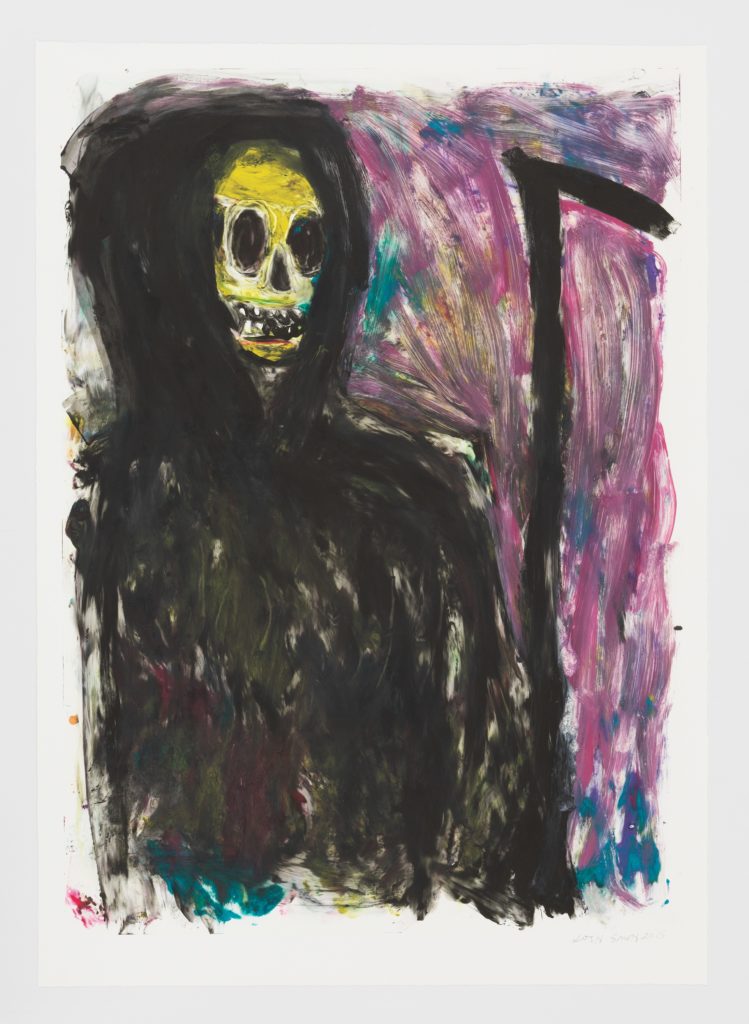
Josh Smith, Untitled, 2015. © Josh Smith. Image courtesy of the artist and David Zwirner, New York/London/Hong Kong.
Zwirner said the main goal of the online viewing room is simple: to attract newcomers. “Needless to say, the online audience is growing in all fields,” he said. “It is an exciting audience, a young audience. And as the gallery is growing, I also understand that there are many, many people that are interested in what we do who can’t come to the physical space, and we want to reach out to them.”
An interest in expanding their audience also helped motivate Gagosian’s recently launched online viewing room project. But this shared desire represents one of the few points of convergence between the two mega-galleries’ digital strategies.
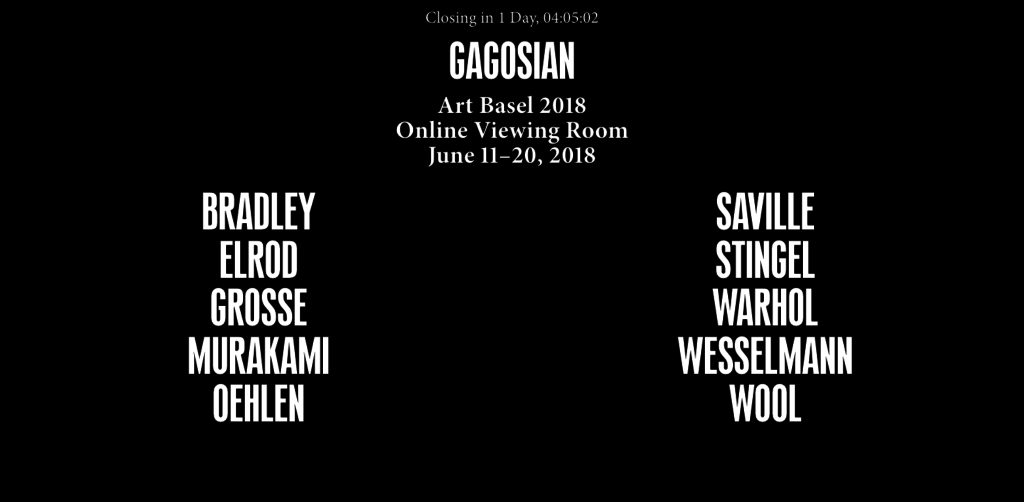
Screenshot of Gagosian’s Art Basel 2018 Online Viewing Room. Courtesy of Gagosian.
Gagosian’s Alternate Approach
For Sam Orlofsky, a director at Gagosian, broadening the gallery’s client base is just one motivation to pop up online. Another is to create an event-driven opportunity for buyers—both old and new, and within a specific price range—at a time when traveling for every major art fair and auction is becoming less and less feasible.
“We look at the ease with which, and the scale at which, Sotheby’s and Christie’s continue to acquire new customers, for lack of a better phrase, or develop new collectors, and that’s something that we wish we could do a better job of,” Orlofsky told artnet News. “And so the question is, what do they do structurally that allows them to acquire more collectors?”
The gallery’s answer to this question was clear: Auction houses have “no barrier to entry,” at least for buyers of means. “If you want to show up and bid, and your credit card info checks out, you can,” he said. “That’s what we don’t do.” So the gallery set out to build an online viewing room that would match—or exceed—auction house standards for access, price transparency, and user experience.
Inside Gagosian’s digital sales platform, visitors click on an artist’s name to find a zoom-able image of an available work installed in a virtual gallery space. Basic details and price information is included below. Clicking “Learn More” unfurls a dedicated essay on each piece, sometimes with additional reference images—highly similar to what you would find in the catalogue for a major evening auction.
Although Gagosian, like Zwirner, required interested parties to interact with gallery staff rather than clicking to buy, its online communication channel provided instant responses. A “Live Assistance” button on each artist’s page connected users to a salesperson on call 24 hours a day for the duration of the viewing room.
This model was only possible because of a key distinction between Zwirner and Gagosian’s initiatives: The latter’s virtual venture was temporary. It was open strictly for a 10-day span bracketing Art Basel in Basel last month. And crucially, this trait originated in the attendance ebb wrought partly by the runaway growth of the 21st-century art market.
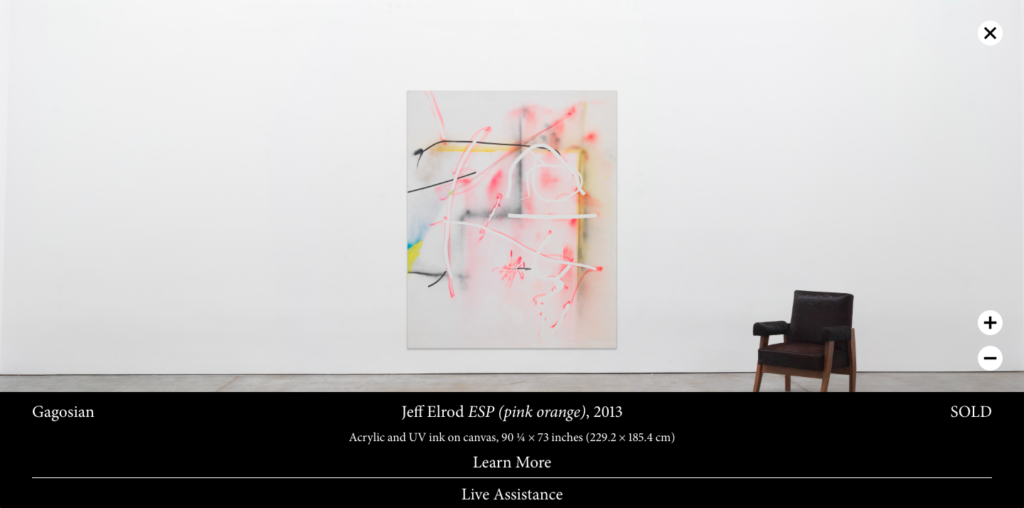
Screenshot of Gagosian’s Art Basel 2018 Online Viewing Room. Courtesy of Gagosian.
Departure Time
Art Basel was not the lone event propelling Gagosian’s first online viewing room. The Swiss fair was only the culmination of a stretch of frenzied sales activity that spanned Frieze New York and a half-month of major New York auctions.
“It used to be that we called it ‘auction week,’” Orlofsky said, “but this really was three weeks, if not longer. And it was very obvious that a lot of people had to choose to show up for a couple days here or a couple days there. They couldn’t allocate a three-week trip to New York to participate in all the offerings that were available.”
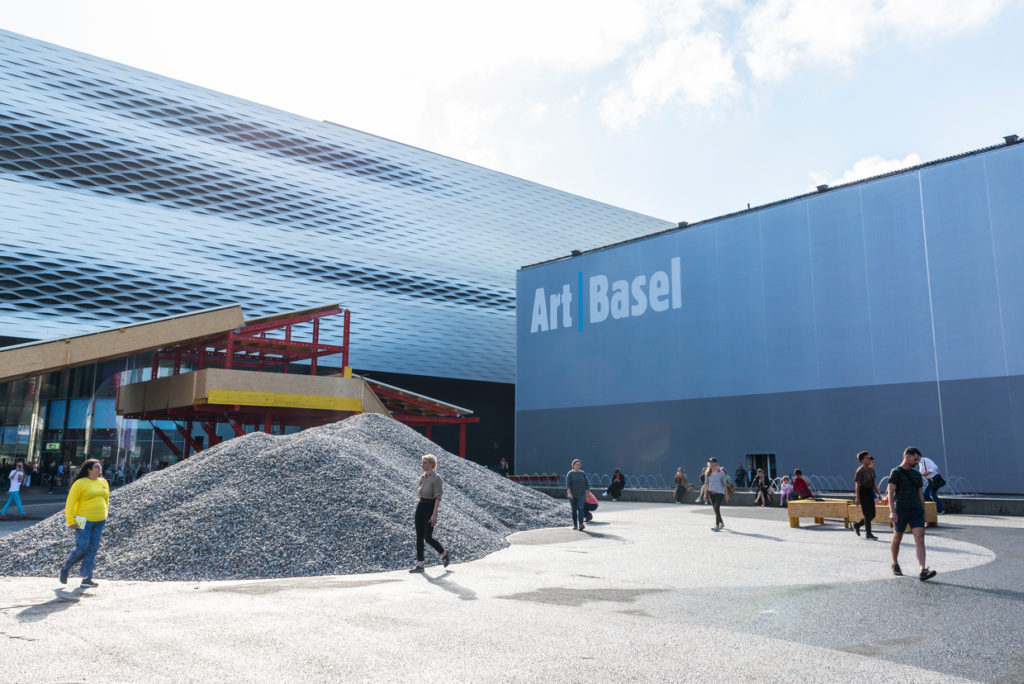
Art Basel 2018 © Art Basel and Creative Time
There was more to the equation, too. Orlofsky notes that he and others at Gagosian had noticed a palpable sense of “burn-out” in the buyer base lately—that, in his words, “more and more people had just stopped showing up in general,” even to major art market events, due to the sheer volume. This led the gallery to suspect that Art Basel 2018 might host precious few members of certain collecting demographics to whom they would offer certain types of work. (And indeed, many dealers noted a precipitous drop in the number of Americans in attendance.)
Creating another portal with a finite lifespan allowed the gallery to recreate the kind of “buy now or bail” pressure collectors feel at art fairs—without actually having to go to one. “If we can find a more efficient portal or tool for them to voyeuristically participate” during Art Basel, Orlofsky recalls discussing, “we might have a better chance of actually doing business.”
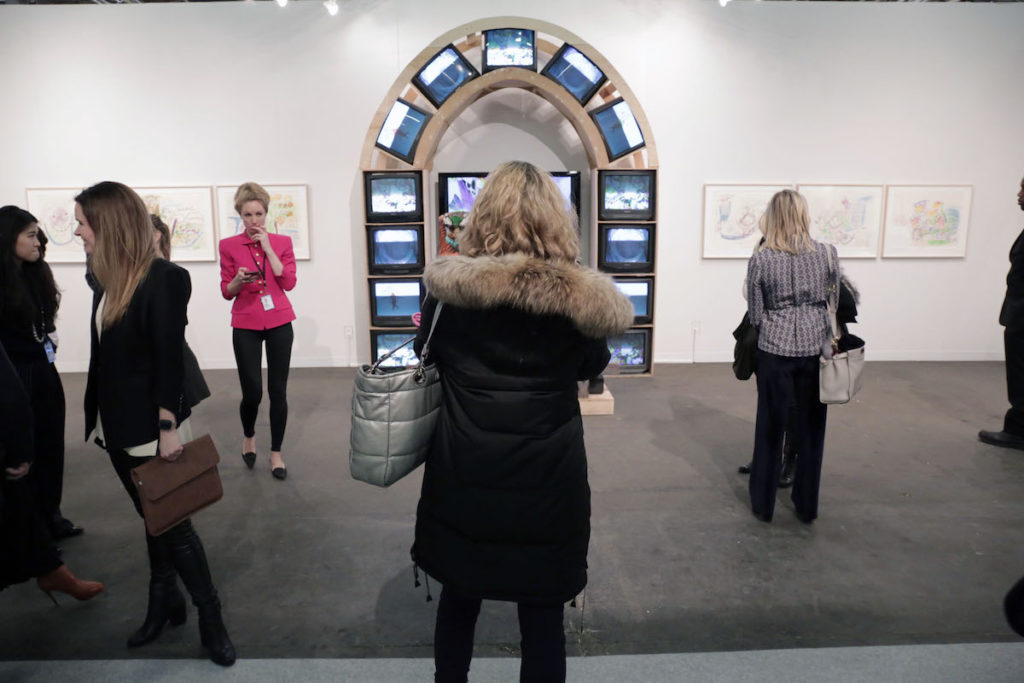
Nam Jun Paik at Gagosian’s 2018 Armory Show booth. Photo: Henri Neuendorf.
Pre-Awareness and Past Narratives
Gagosian also carefully chose the works in the viewing room, both to get the maximum impact for its investment and to test the orthodoxy of what sells online. At Art Basel, the gallery normally dedicates its booth to ultra-high-end secondary market work that often exceeds seven figures. Online, though, the gallery chose work that was higher in price than most people would expect to see on a digital sales platform—but not so high that the work could only realistically be placed if it were shipped to Switzerland for in-person presentations.
Orlofsky notes that the refrain among many market pros is that the “sweet spot” for selling online hovers around $20,000, and that the ideal pieces are “Pop-y works by household names in large editions.” While he admits there may be truth to this narrative on the whole, he also suspects that dealers “often limit themselves only to [offering] that work, and it becomes a self-fulfilling prophecy, where then of course that’s the work that sells.”
So he and his colleagues at Gagosian deliberately curated their online viewing room to test the narrative. The lowest-priced work on offer, a Jeff Elrod painting, was listed at $150,000. The other nine works scaled up significantly from that baseline.
While the gallery intended to expose newcomers to the material, it also chose works that it was fairly certain it could sell to established clients. “For the primary market artists we have in great demand, the demand is so great, we don’t need to take them to an art fair to find out who’s interested,” explained Orlofsky. “We know.”
This market pre-awareness—the type that commercially elite galleries enjoy—makes the necessities of art-fair presentations seem all the more dubious. Why pay to insure, ship, and install a piece internationally, let alone subject it to all the risks that process entails, if you already have a short list of collectors likely to buy it?
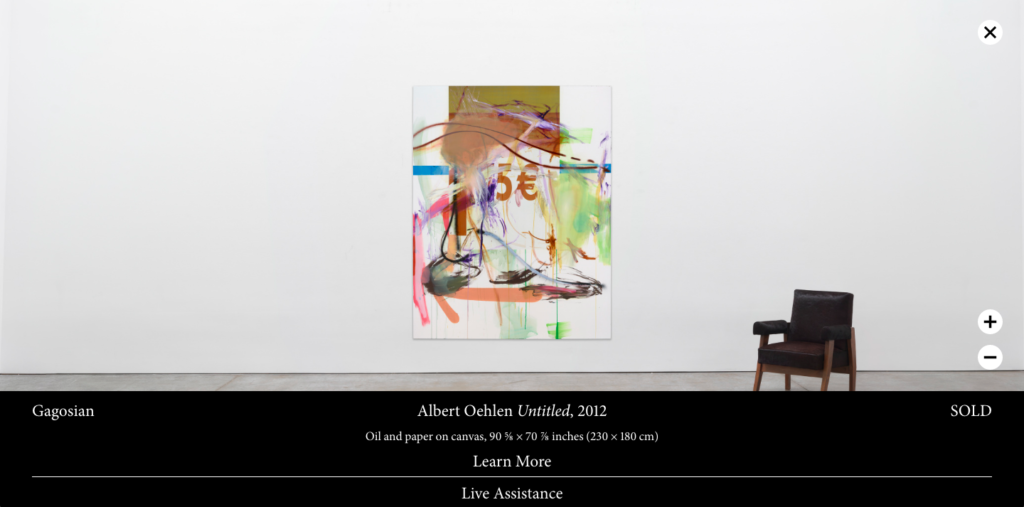
Screenshot of Gagosian’s Art Basel 2018 Online Viewing Room. Courtesy of Gagosian.
Early Returns
So how did Gagosian’s digital campaign do? “We were shocked, honestly,” says Orlofsky. “It exceeded our wildest dreams.” According to the gallery, half of the 10 works found buyers in the viewing room’s 10 days of operation. Along with the Elrod, Gagosian placed a $225,000 Rudolf Stingel, a €200,000 (roughly $230,000) Katharina Grosse, a $275,000 Joe Bradley, and the crown jewel, a €950,000 (roughly $1.1 million) Albert Oehlen.
From a valuation standpoint, then, Orlofsky believes that the gallery’s digital success “shows people have completely shifted their threshold of what they’re comfortable with [online],” provided the right variables are in place. The project was a resounding victory in terms of exposure, as well. According to a Gagosian spokeswoman, the online viewing room led to 537 new collector contacts, counted nearly 25,000 total unique users, and logged over 117,000 page views.
It also validated the larger strategy behind the initiative. Although Gagosian will make minor tweaks to the format, the gallery plans to present only a handful of online viewing rooms per year—each one a time-limited affair synced to another period of overwhelming activity in the art market. The next likely trigger will be Frieze London.

Josh Smith, Untitled, 2014. © Josh Smith. Image courtesy of the artist and David Zwirner, New York/London/Hong Kong.
Zwirner, too, reports strong digital results. Five of the Josh Smith works in its current online viewing room were sold by publication time, and other virtual exhibitions have performed even better. A presentation of Yayoi Kusama’s prints, all in the $15,000 to $20,000 range, sold out within a week last November. The initiative has been effective in attracting new audience members, too. According to a gallery representative, 37 percent of all online viewing room inquiries to date have come from new clients.
The results give Zwirner reason to be optimistic. He says of the project, “When we started I wasn’t sure where it was going to go. But now I feel that it’s going to be an important part of what we do in two years, three years, five years, and I’m really excited about that.” The early success has even motivated him to hire a director dedicated to the project, who will begin this fall.
There is a wider-screen takeaway from these mega-gallery success stories, too—one that applies to all sectors of the industry. “Obviously, there are a lot of changes occurring in people’s buying habits and patterns, and the more quickly you can identify them on the business side, the more quickly you can adapt to them,” Orlofsky said. “The goal is to not be in denial, not be stubborn, not say, ‘This is the way we’ve always done things.’”
The flexibility and open-mindedness are laudable. As for buyers’ growing comfort with bypassing the in-person viewing (and buying) experience for a digital substitute? That’s a trend whose consequences the wider art world is still processing.
Follow Artnet News on Facebook:
Want to stay ahead of the art world? Subscribe to our newsletter to get the breaking news, eye-opening interviews, and incisive critical takes that drive the conversation forward.
















